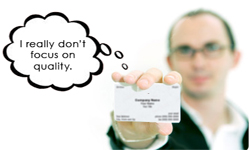The most basic function of a business card is to pass on your information. But your card might be telling potential customers something else. Make sure you create the memory you want.
Think about your own experiences when you receive a card. Is it flimsy or rigid? Does it look like 50 other cards or do you take a second look? Some people might not recognize me at first, but once I hand them my card, they say: “I’ve met you before. I’ve seen this card.”
Here are things to think about when looking at your business card:
Have the correct information – If your card is out of date, get it reprinted.
DO NOT cross out numbers!
List vital information such as name, phone, address, email, and website (yes, everyone should have a website), and perhaps a catch phrase or a few bullet points that make you stand out.
Do not list everything you do or sell. Make the design of the card sell you, not the wording. Do people know what you do with a quick glance at your card? Or are they curious?
Size matters – Believe it or not some people still use rolodexes. In fact, I use a folder with business card sheets to keep the fantastic cards I receive. So make sure your card fits the 3.5″x2″ standard holder. It can be smaller, it can fold, or have a unique shape; just make sure people can save your information.
Keep it simple – Do not use a lot of fonts or images. Follow your business brand.
Use both sides. Be aware of your habits. Do you take notes on the back, write appointment times down, or write a special offer? THEN LEAVE SPACE ON THE BACK.
Do you leave a lot of cards in places where you never meet the potential clients? What would you tell them about your business if you were there? THIS IS WHAT YOU SHOULD PUT ON YOUR CARD. Again, keep it simple.
Cohesive Identity – Make sure your business card reflects your other marketing collateral. Use your colors and logo to create a memory.
Quality counts, not quantity – This cliché applies to clothes, cars, computers, and yes, business cards. Sure, online vendors supply cheap cards, but you can never predict quality. A reliable printer is worth his (or her) weight in gold, and you can develop a special card by investing a little in printing.
Choose a graphic designer to help you communicate your true vision while understanding your budget limitations – There are solutions for all budgets. So, find a designer who can teach you ways to maximize your resources, such as the difference between digital and offset printing, and PMS colors or CMYK process printing. Choose a designer you can grow with over time, and who will come to understand your evolving needs as a business owner.
Reach out and touch – The sense of touch is acute and thrives on contrast and variety. Sight, smell, and hearing can be experienced from far, but our touch forces us to physically experience life. So, don’t downplay the importance of the tactile qualities of your business card. Choose thick, textured, smooth, waxy, metal, wood, hand-made, and other types – the material and treatment will say something about your company, and create a meaningful experience for the receiver. So make it count.
Click on the links below for wonderful examples to get your creative juices flowing.

